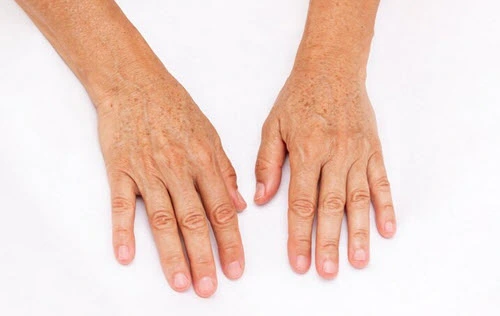What are Age Spots?
Also called solar lentigines, age spots refer to the brownish areas that appear over time on your face and body. Age spots occur as a result of overexposure to the sun. Often seen on people over 40, anyone can have age spots.
Usually, age spots do not cause any problems and do not require medical care. If the spots are especially dark or have changed in appearance, have your physician exam them to make sure there is no risk of skin cancer. After a visual inspection, your doctor can determine if the area needs to be biopsied.

What are the causes of Age Spots?
Melanin, the dark pigment in the epidermis, gives the skin its pigment. Extra melanin, which protects the deeper layers of skin, causes the darker color of a tan. When extra melanin is generated or it becomes clumped in one location, age spots appear. Usually, age spots develop after years of exposure to the sun, but tanning lamps and tanning beds can eventually lead to the same results. Genetics and the natural aging process can also influence whether you have age spots or not.
What treatments are available for Age Spots?
If age spots make you feel self-conscious about how you look, schedule an appointment with dermatologist name to learn about treatment options to remove or lighten age spots, including:
- Medications to gradually fade the spots
- Fractional laser resurfacing and light therapy to wipe out the extra melanocytes
- Cryotherapy to destroy the extra pigment
- Dermabrasion to remove the surface layer of skin
- Chemical peel to fade age spots
How to help prevent Age Spots
Minimizing exposure to the sun will reduce your odds of developing age spots.
Follow these tips as well:
- Avoid tanning beds or lamps
- Choose a broad-spectrum sunscreen with an SPF of 30 to 50 or greater and reapply often
- Cover skin with hats, long sleeves and long pants
- Limit outdoor time during peak sun hours

The Difference Between Age Spots and Other Skin Conditions
Age spots are small, flat dark areas on the skin that are usually tan to dark brown. They are caused by overactive pigment cells due to sun exposure or tanning beds. They are common in adults older than 50 and appear on areas that are most exposed to the sun, such as the face, hands, shoulders and arms.
Moles are growths on the skin that can be flesh-colored, brown, or black. They can appear anywhere on the skin, alone or in groups. They can be benign (non-cancerous) or malignant (cancerous), which is why it is important to monitor them for change.
Freckles are tiny, flat, circular spots that are typically beige or brown in color. They appear in groups on areas of the skin that are regularly exposed to the sun, such as the face, arms, and legs. They often become darker after sun exposure and significantly lighten up in the winter months. They are not harmful and do not need treatment, but they can be reduced or eliminated by topical skin care products or laser treatments.
FAQ About Age Spots
Are age spots dangerous?
Age spots are generally harmless and do not require treatment. However, if a person notices a new spot on their skin, or a spot that changes in size, shape, or color, they should consult a dermatologist as it could be a sign of a more serious skin condition such as skin cancer.
How can I prevent age spots?
Can age spots be treated or removed?
Are age spots only found in older people?
Can age spots appear on other parts of the body besides the face, hands and arms?
Age spots can appear on any part of the body that has been exposed to the sun. They are commonly found on the face, hands, and arms, but they can also appear on the legs, back, and chest. It’s important to check all exposed areas of the skin for age spots, especially if you have a history of sun exposure or sunburns.
Can age spots be mistaken for something else?
Is there a dermatologist near me in Stockton that offers treatment for age spots?
Yes. At our Stockton dermatology office we offer treatment for age spots to patients from Stockton and the surrounding area. Contact our office today to schedule an appointment.

